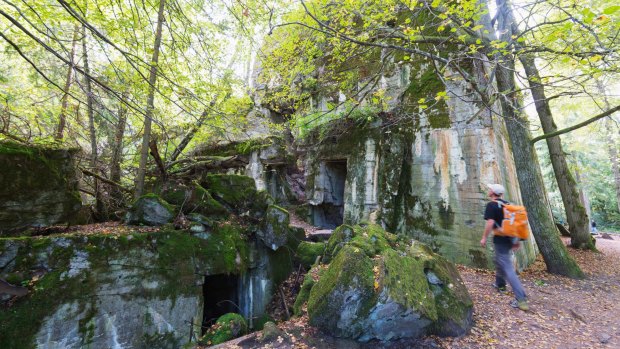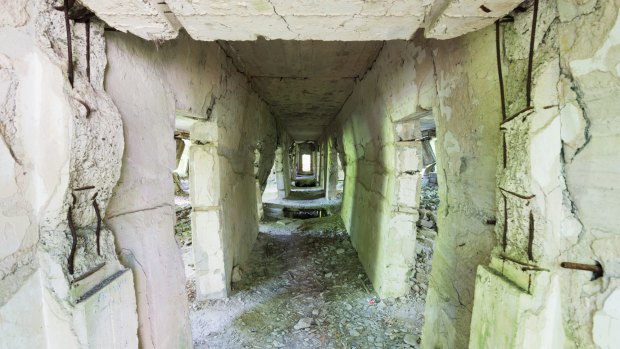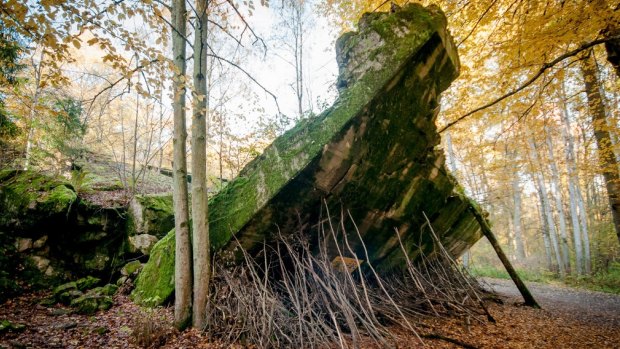This was published 4 years ago
The Wolf's Lair, Poland: Hitler's World War II secret bunkers where he nearly met his end
By Tim Richards

The Wolf's Lair, Hitler's World War II secret bunker.Credit: Alamy
It's unnerving to stand at a location which was almost a turning point in history.
At my feet is a monument resembling the crumpled pages of an open book. One side is inscribed in Polish lettering, the other side in German. It marks the conference room where, on 20 July 1944, Claus von Stauffenberg attempted to assassinate Adolf Hitler with a bomb.
The attempt, dramatically recreated in the Tom Cruise movie Valkyrie, very nearly succeeded. If it hadn't been for a change of venue the bomb would have exploded inside a bunker, concentrating the blast, and the history of the Second World War would have been quite different.

The Wolf's Lair, Ketrzyn, Poland.Credit: Alamy
It's an incident worthy of reflection, magnified by the eerie nature of the complex within which the memorial stands. For this is the Wolf's Lair (Wilczy Szaniec in Polish, Wolfsschanze in German) in northeast Poland. It was Hitler's Russian Front headquarters, in which the German dictator lived for most of the period between 1941 and 1944.
This military base was built within a forest in what was then Germany, hidden by trees and camouflage netting. As the Soviet Union's army approached in late 1944, the order was given to demolish it with explosives. But the enormous concrete bunkers were so hefty, with two metre thick walls, they were merely left fractured and broken.
The result is a fascinating collection of shattered buildings scattered through the woods, in equal parts creepy and thought-provoking.

Bunker slab at the Wolf's Lair.
It's possible to wander the Wolf's Lair independently, but it's worth hiring an onsite guide to receive the full picture. My guide, Jadwiga Korowaj, is well versed in the history of this unusual attraction.
From the memorial she leads me deeper into the site, to the first of the craggy grey bunkers. They strike a gloomy contrast to the green of the woods, the sun throwing dappled shade onto the paths which thread between them.
In this forest setting, the bunkers seem like fragments of a dark fairytale told by the Brothers Grimm. But the legacy of the base was all too real. Korowaj points out a memorial to Polish sappers who cleared over 50,000 mines from the land after the war, to return it to farming.
We step through the remains of Bunker 6, whose huge blocks of concrete are studded with twisted rods. Then we pass the former typists' office, from whose ceiling there are stalactites growing.
Beyond Bunker 11, the base of Hitler's private secretary Martin Bormann, I see a huge slab of wall lying at a 45 degree angle from the ground. Beneath it and the ground, as if propping it up, are dozens of sticks. They've been placed here by visitors as a ritual of good luck, a gesture that recurs elsewhere in the site.
Finally, we reach Bunker 13, Hitler's own, although he never had much use from it. By the time it was completed in late 1944, the Red Army was approaching and he had to flee to Berlin. On one side there was a smaller bunker which served as a kitchen, on the other was a tea house. It seems strange to consider people visiting a café as part of their daily routine in this grim place.
As if sensing my thoughts, Korowaj points out the meadow where Hitler used to exercise his dog. Then we walk around Bunker 13, noting walls with jagged fault lines, big chunks of concrete on a lean, and more slabs with branches propped beneath them for luck.
At the end of the tour we drink coffee in the onsite restaurant, one of the few buildings still intact from the 1940s. It's a chance to reflect on what I've seen in this leafy corner of Poland, within a beautiful forest with a dark past.
TRIP NOTES
FLY
Emirates flies to Warsaw via Dubai (see emirates.com.au). From Warsaw the Wolf's Lair can be reached by train from nearby Ketrzyn, see rozklad-pkp.pl
STAY
Hotel Koch provides comfortable accommodation from $80 a night in Ketrzyn, 8 kilometres from the Wolf's Lair, see hotelkoch.pl
TOUR
The Wolf's Lair can be reached by taxi or local bus from Ketrzyn, entry fee $5.50. English-speaking guides are available for $30 (see it.ketrzyn.pl). Guide Jadwiga Korowaj can be booked directly by emailing jagoda10@poczta.onet.pl
MORE
Tim Richards was a guest of Poland's Ministry of Foreign Affairs.
Sign up for the Traveller Deals newsletter
Get exclusive travel deals delivered straight to your inbox. Sign up now.